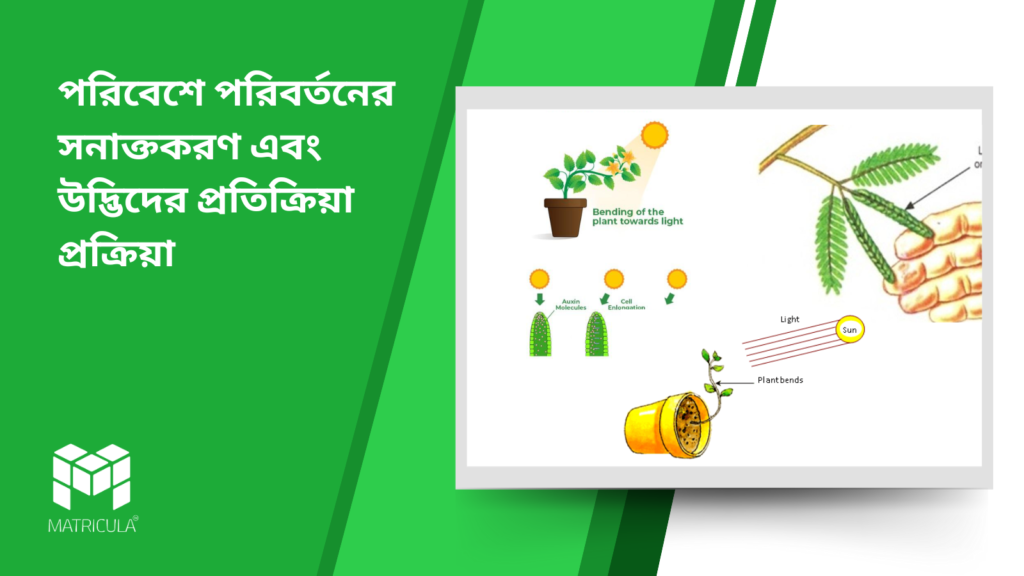Introduction
Plants, like other living organisms, respond to changes in their environment. Although they lack a nervous system, they can detect external stimuli such as light, gravity, touch, and chemicals. These responses are vital for their survival, growth, and reproduction. Plant movements are categorized into various types based on the nature of the stimulus and the direction of the response.
Types of Plant Movements
Plant movements are broadly classified into three types:
- Tactic Movements
- Tropic Movements
- Nastic Movements
1. Tactic Movements
Tactic movements are directional movements in which the entire plant body or its parts move toward or away from an environmental stimulus. These movements are mostly seen in unicellular or aquatic plants.
Types of Tactic Movements:
- Phototactic Movement: Movement in response to light. Example: Certain algae move towards light for photosynthesis.
- Chemotactic Movement: Movement in response to chemicals. Example: Sperm cells in bryophytes and pteridophytes move toward female sex organs using chemical signals.
- Thermotactic Movement: Movement in response to temperature changes.
2. Tropic Movements
Tropic movements are directional movements that occur in response to an external stimulus. These movements are growth-based and are usually permanent.
Types of Tropic Movements:
- Phototropism: Movement of plant parts toward or away from light. Example: Shoots bend toward light (positive phototropism), while roots grow away from light (negative phototropism).
- Geotropism (Gravitropism): Movement in response to gravity. Example: Roots grow downward (positive geotropism) and shoots grow upward (negative geotropism).
- Hydrotropism: Movement in response to water. Example: Roots grow toward moisture.
- Thigmotropism: Movement in response to touch. Example: Tendrils of climbing plants coil around a support.
- Chemotropism: Movement in response to chemicals. Example: Pollen tube growth toward the ovule in flowering plants.
3. Nastic Movements
Nastic movements are non-directional responses to stimuli such as temperature, humidity, and touch. Unlike tropic movements, the direction of the response is independent of the stimulus direction.
Types of Nastic Movements:
- Photonasty: Movement in response to light intensity. Example: Flowers like Datura open in the morning and close in the evening.
- Thermonasty: Movement in response to temperature changes. Example: Tulip flowers bloom when the temperature rises.
- Thigmonasty (Seismonasty): Movement in response to touch or mechanical stimulus. Example: The leaves of the Mimosa pudica plant fold when touched.
- Nyctinasty: Movement associated with day and night changes. Example: The folding and unfolding of leaves in certain plants like prayer plants.
Conclusion
Plants possess remarkable mechanisms to respond to environmental changes, enabling them to adapt, grow, and thrive in various conditions. Understanding these movements helps in agricultural practices, plant growth management, and biological research. These fascinating responses demonstrate that although plants may seem passive, they actively interact with their surroundings in complex ways.
পরিবেশে পরিবর্তনের শনাক্তকরণ এবং উদ্ভিদের প্রতিক্রিয়া প্রক্রিয়া
উদ্ভিদ, যদিও স্থির, তবুও পরিবেশগত পরিবর্তনের প্রতি চমৎকার প্রতিক্রিয়া প্রদর্শন করে। তাদের বেঁচে থাকা, বৃদ্ধি এবং পুনরুৎপাদনের জন্য এই প্রতিক্রিয়াগুলি অত্যন্ত গুরুত্বপূর্ণ। প্রাণীদের মতো চলাফেরা না করেও উদ্ভিদ বিশেষ প্রক্রিয়ার মাধ্যমে বাহ্যিক উদ্দীপনা শনাক্ত ও প্রতিক্রিয়া জানায়। এই প্রক্রিয়াটিকে বলা হয় উদ্ভিদের চলন। উদ্ভিদের চলন প্রধানত তিন প্রকারের হয়: ট্যাকটিক গতি, ট্রপিক গতি, এবং ন্যাস্টিক গতি।
১. ট্যাকটিক চলন
ট্যাকটিক গতি হলো এমন একটি দিকনির্দেশিত প্রতিক্রিয়া যেখানে সমগ্র উদ্ভিদ বা তার কিছু অংশ উদ্দীপনার দিকে বা বিপরীত দিকে চলে যায়। সাধারণত নিম্ন শ্রেণির জীব যেমন শৈবালদের ক্ষেত্রে এটি দেখা যায়। ট্যাকটিক গতির প্রকারভেদ:
- ফোটোট্যাকটিক চলন
- : আলোকে সাড়া দিয়ে হওয়া গতি। যেমন, Chlamydomonas আলোর দিকে চলে যায় যাতে সে পর্যাপ্ত আলোক সংশ্লেষণ করতে পারে।
- কেমোট্যাকটিক চলন: রাসায়নিক উদ্দীপনার প্রতি সাড়া দিয়ে হওয়া গতি। যেমন, Bryophytes এবং Pteridophytes এর পুরুষ গ্যামেট স্ত্রী প্রজনন অঙ্গের দিকে রাসায়নিক পদার্থ দ্বারা আকৃষ্ট হয়ে চলে যায়।
- হাইড্রোট্যাকটিক চলন: পানির ঘনত্বের প্রতি সাড়া দিয়ে হওয়া গতি। শৈবাল এবং কিছু জলজ উদ্ভিদ হাইড্রোট্যাকটিক গতির মাধ্যমে নিজেদের পানির উৎসের দিকে নিয়ে যায়।
২. ট্রপিক চলন
ট্রপিক চলন হলো এমন এক ধরনের বৃদ্ধি সংশ্লিষ্ট গতি যা নির্দিষ্ট দিকনির্দেশিত উদ্দীপনার প্রতিক্রিয়ায় ঘটে। এই ধরনের গতি ধীরগতির হয় এবং এতে বক্রতার সৃষ্টি হয়। ট্রপিক গতির প্রকারভেদ:
- ফোটোট্রোপিজম: আলোকে সাড়া দিয়ে বৃদ্ধি ঘটে। যেমন, সূর্যমুখী গাছের কাণ্ড সূর্যের দিকে বাঁকিয়ে বৃদ্ধি পায়।
- জিওট্রোপিজম: মাধ্যাকর্ষণের প্রতিক্রিয়ায় হওয়া বৃদ্ধি। শিকড় মাটির নিচে নেমে যায় (পজিটিভ জিওট্রোপিজম), আর কাণ্ড ওপরে উঠে যায় (নেগেটিভ জিওট্রোপিজম)।
- হাইড্রোট্রোপিজম: জলের প্রতি সাড়া দিয়ে বৃদ্ধি। উদাহরণস্বরূপ, শিকড় মাটির আর্দ্রতার দিকে বাড়ে।
- থিগমোট্রোপিজম: স্পর্শের প্রতি সাড়া দিয়ে বৃদ্ধি। যেমন, মটর গাছ ও শসা লতা তাদের অঙ্গ স্পর্শের উৎসের চারপাশে মোড় নেয়।
- কেমোট্রোপিজম: রাসায়নিকের প্রতি সাড়া দিয়ে বৃদ্ধি। যেমন, ফুলের পরাগনালিকা ডিম্বাশয়ের দিকে বাড়ে।
৩. ন্যাস্টিক চলন
ন্যাস্টিক গতি হলো অ-দিকনির্দেশিত প্রতিক্রিয়া যা উদ্দীপনার নির্দিষ্ট দিকের উপর নির্ভরশীল নয়। এই গতি সাধারণত কোষের টার্গার চাপের পরিবর্তনের মাধ্যমে ঘটে। ন্যাস্টিক গতির প্রকারভেদ:
- ফোটোন্যাস্টিক: আলোকে সাড়া দিয়ে হওয়া গতি। যেমন, Dandelion ফুল সূর্যের আলোয় ফোটে এবং রাতে বন্ধ হয়ে যায়।
- নিক্টিন্যাস্টিক: রাত্রিকালীন গতি, যেমন Mimosa pudica (লজ্জাবতী) গাছের পাতাগুলি রাতে বন্ধ হয়ে যায়।
- থিগমন্যাস্টিক: স্পর্শের প্রতি সাড়া দিয়ে হওয়া গতি। যেমন, Mimosa pudica গাছের পাতা স্পর্শ করলে দ্রুত ভাঁজ হয়ে যায়।
- থার্মোন্যাস্টিক: তাপমাত্রার পরিবর্তনের কারণে হওয়া গতি। যেমন, উষ্ণ পরিবেশে Crocus ফুল ফোটে।
উদ্ভিদের চলনের প্রক্রিয়া
উদ্ভিদের গতি সাধারণত নিম্নলিখিত প্রক্রিয়াগুলির মাধ্যমে ঘটে:
- টার্গার চাপের পরিবর্তন: কোষের টার্গার চাপ দ্রুত পরিবর্তন হলে যেমন Mimosa pudica গাছের পাতা স্পর্শে ভাঁজ হয়ে যায়।
- বৃদ্ধি নিয়ন্ত্রণ: ট্রপিক গতি ঘটে কোষের বিপরীত পাশে অমসৃণ বৃদ্ধির কারণে।
- হরমোন নিয়ন্ত্রণ: উদ্ভিদ হরমোন যেমন অক্সিন, জিব্বেরেলিন এবং সাইটোকিনিন কোষের প্রসারণ ও বিভাজন নিয়ন্ত্রণ করে গতি নিয়ন্ত্রণে ভূমিকা রাখে।
উপসংহার
উদ্ভিদ পরিবেশগত পরিবর্তনের প্রতি ট্যাকটিক, ট্রপিক এবং ন্যাস্টিক গতি দ্বারা প্রতিক্রিয়া জানায়। এই অভিযোজনমূলক প্রতিক্রিয়াগুলি তাদের সম্পদ সংগ্রহ, দক্ষতার সাথে বৃদ্ধি এবং বিভিন্ন অবস্থায় টিকে থাকার জন্য গুরুত্বপূর্ণ। এই প্রক্রিয়াগুলি বোঝার মাধ্যমে উদ্ভিদের আচরণ এবং তাদের পরিবেশের সাথে যোগাযোগ সম্পর্কে গভীর ধারণা পাওয়া যায়।




